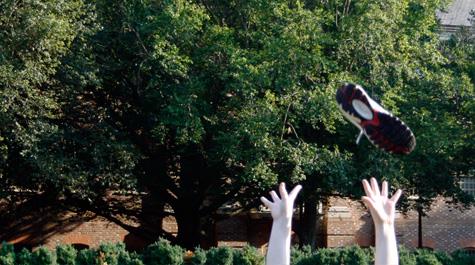Field Day for the Brain
A psychology class discovers that sometimes the best way to get smart is to look a little stupid.
There are 300 brains in Professor Constance Pilkington’s Psychology 201 class, most of them locked safely inside the skulls of William & Mary undergraduates.
On this sunny fall day, Pilkington is explaining the complex electrochemical process that makes neurons fire. And if you lean in close enough to a student’s head, you can almost hear the snap, crackle, pop of flickering brain cells.
Professor Pilkington is the first to admit that lecturing a large group of students about electrochemical reactions can be a bit dry. Luckily, she has a few sparky neurons of her own.
“A few years ago, right before class, I was bemoaning the fact that I was going to have to talk about the neuron,” says Pilkington. “And I thought, ‘What can I do to make this more interesting?’ On the spur of the moment, I decided, OK, I’m going to take my 300 students outside of the lecture hall—there’s a field right by us—and we’re going to enact a neuron firing.”
What followed was nothing short of an educational breakthrough, in a second-grade recess kind of way. She grabbed a stack of red construction paper and a stack of green construction paper and handed them out to a bunch of the students. Then she told the rest of them to line up in rows of four in a long formation at the end of the field.
The students with the green and red paper, Pilkington explains, represent the two basic types of neurotransmitters: excitatory (green) and inhibitory (red). The students in formation represent the long, stringy neuron cell.
When Pilkington yells “Go!” groups of students carrying red and green paper race across the field toward the front of the formation, where the dendrite is located on a neuron. The dendrite’s job is to trigger the electrochemical reaction when it receives enough excitatory signals.
As more and more green paper arrives at the dendrite, Pilkington gives the sign for the reaction to begin. The dendrite row of students turn and wave to the next row of students, who represent something called the axon hillock.
“Then the axon hillock starts a stadium wave,” explains Pilkington. “That goes row by row, down the line until the last row, the terminal buttons, who throw a shoe in the air.” And that, my friends, is how a neuron fires.
Pilkington’s been teaching at W&M for 18 years and encouraging students to throw their shoes at each other for four.
“It’s a silly, stupid exercise, but ever since I started doing it I do it every year,” says Pilkington. “It’s the last thing we do on that day, and it’s amazing. They remember. They remember how it works after we do that.”
 Skip to main content
Skip to main content


